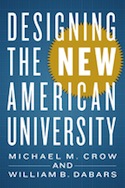
Contemporary American universities receive a great deal of criticism, but much of it is not particularly constructive. What should a 21st-century university look like, and whom should it serve? Arizona State University president Michael M. Crow, who has been wrestling with these questions at ASU and in his previous work at Columbia University, visits Zócalo to discuss what universities are for along with New York Times columnist Frank Bruni. In advance of their discussion, below is an excerpt from Crow’s new book, Designing the New American University.
 When I became president of Arizona State University in July 2002, I came to the office following more than a decade at Columbia University, where I had served as a professor of science and technology policy as well as an administrator and designer of new initiatives, culminating in an appointment as executive vice provost. The contrast between Columbia, which began as one of the elite colonial colleges that would come to constitute the Ivy League, and Arizona State, a burgeoning but then still largely undifferentiated regional public university, epitomized the heterogeneity and diversity in mission and scale of operation of the roughly 200 institutions in the United States characterized as research universities. Established prior to the American Revolution as King’s College, Columbia epitomizes the institutional model of the highly successful gold standard in American higher education. Like its institutional peers, public as well as private, the school may boast not only of its achievements but also the rigors of its selectivity. By contrast, ASU is the nation’s youngest major research university and, with an enrollment of undergraduate, graduate, and professional students presently exceeding 76,000, one of the nation’s largest public universities governed by a single administration. Yet, whereas Columbia and its institutional peers deviate little from a familiar trajectory charted in some cases centuries in the past, ASU has deliberately undertaken an exhaustive reconceptualization to emerge as one of the nation’s leading public metropolitan research universities, an institution that combines accessibility to an academic platform underpinned by discovery and knowledge production, inclusiveness to a broad demographic representative of the socioeconomic diversity of the region and nation, and maximum societal impact—a model I have termed the “New American University.”
When I became president of Arizona State University in July 2002, I came to the office following more than a decade at Columbia University, where I had served as a professor of science and technology policy as well as an administrator and designer of new initiatives, culminating in an appointment as executive vice provost. The contrast between Columbia, which began as one of the elite colonial colleges that would come to constitute the Ivy League, and Arizona State, a burgeoning but then still largely undifferentiated regional public university, epitomized the heterogeneity and diversity in mission and scale of operation of the roughly 200 institutions in the United States characterized as research universities. Established prior to the American Revolution as King’s College, Columbia epitomizes the institutional model of the highly successful gold standard in American higher education. Like its institutional peers, public as well as private, the school may boast not only of its achievements but also the rigors of its selectivity. By contrast, ASU is the nation’s youngest major research university and, with an enrollment of undergraduate, graduate, and professional students presently exceeding 76,000, one of the nation’s largest public universities governed by a single administration. Yet, whereas Columbia and its institutional peers deviate little from a familiar trajectory charted in some cases centuries in the past, ASU has deliberately undertaken an exhaustive reconceptualization to emerge as one of the nation’s leading public metropolitan research universities, an institution that combines accessibility to an academic platform underpinned by discovery and knowledge production, inclusiveness to a broad demographic representative of the socioeconomic diversity of the region and nation, and maximum societal impact—a model I have termed the “New American University.”
In this book, my colleague William Dabars and I consider both the scope and complexity of the set of American research universities and the various contexts within which their contributions to society, as well as the dilemmas and challenges these institutions routinely encounter, may be addressed. We concur with Frank Rhodes, president emeritus of Cornell University, in his assessment that “the university is the most significant creation of the second millennium.” More than other institutional types, major research universities leverage the potential of knowledge production, and their significance increases with each passing year as the role of knowledge becomes ever more crucial. Our society depends increasingly on the educated citizens and ideas, products, and processes these institutions produce as their integrated platforms of teaching and research contribute to our economic and global competitiveness as well as standard of living and quality of life. These institutions represent our best hope for the survival of our species. While the reconceptualization of ASU represents the pioneering of a foundational prototype for a New American University, more broadly, the “design process” undertaken during the past decade constitutes a recasting of the American research university as a complex and adaptive comprehensive knowledge enterprise committed to discovery, creativity, and innovation, accessible to the broadest possible demographic, both socioeconomically and intellectually. These commitments together imply scalability at a level previously considered improbable if not undesirable.
An objective assessment of our knowledge enterprises undertaken with sufficient perspective—perhaps from the distance of the Oort Cloud, as once suggested by University of Michigan president emeritus James Duderstadt—discloses any number of fundamental design limitations. We face social and environmental challenges of unimaginable complexity, but rather than restructuring institutional operations to embrace and manage complexity, academic culture perpetuates existing organizational structures and practices and restricts its focus with disciplinary entrenchment and increasing specialization. Our universities sometimes appear hesitant to mount operations to address these challenges in real time and retreat instead to the comfort zone of abstract knowledge. The organizational frameworks we call universities—this thousand-year-old institutional form—have not evolved significantly beyond the configurations assumed in the late 19th century, nor have differentiated new designs come to the fore. As the lead architect in the design of a new class of large-scale multidisciplinary and transdisciplinary institutions during the past two decades, both at Columbia and now in Arizona, I recognize that although institutional reconceptualization is not without its pitfalls given inherent sociocultural barriers, new models offer new ways of shaping and examining problems and advancing questions through cooperation among large numbers of teams, programs, and initiatives.
Although the effort to transform a large public university into an adaptive knowledge enterprise in real time and at scale is unusual if not unprecedented, the reconceptualization has allowed the academic community to reassess its priorities. In many instances the design process has offered an opportunity for faculty and researchers to reaffirm their commitment to serve society, spurring efforts to advance innovation commensurate with the scale and complexity of the challenges that confront the global community. And because concern with tackling the grand challenges has become engrained in our institutional culture, the teaching and research enterprise of the university sometimes takes on the characteristics of a moonshot project. “Moonshot thinking starts with picking a big problem: something huge, long existing, or on a global scale,” writes Astro Teller, who directs Google X, which he describes as the corporate “moonshot factory.” “Next it involves articulating a radical solution—one that would actually solve the problem if it existed … Finally, there needs to be some kind of concrete evidence that the proposed solution is not quite as crazy as it first seems; something that justifies at least a close look at whether such a solution could be brought into being if enough creativity, passion, and persistence were brought to bear on it.” The reconceptualization of Arizona State University could in some sense be likened to a moonshot project, as well as some of the initiatives of its teaching and research enterprise, which we delineate in this book. It is therefore to the entire academic community of the past decade, whose commitment to excellence and accessibility and unfailing willingness to innovate have made the design process possible, that I wish to dedicate our book. Creativity, passion, and persistence are hallmarks of the American research university, and to adapt a concept from the thinkers at Google, which through innovation has undertaken a corporate initiative to Solve for X, we might well say that a hallmark of a New American University is the willingness to attempt to solve for X with U.




Send A Letter To the Editors